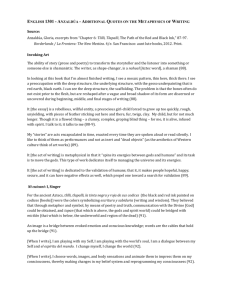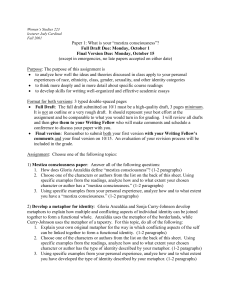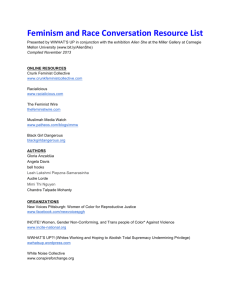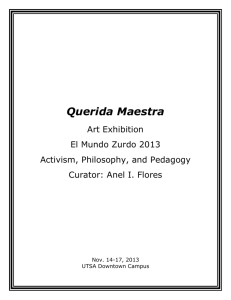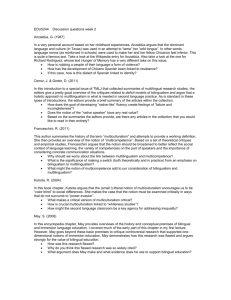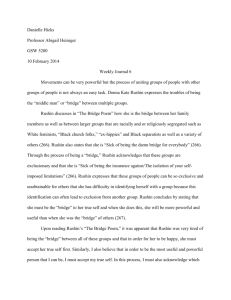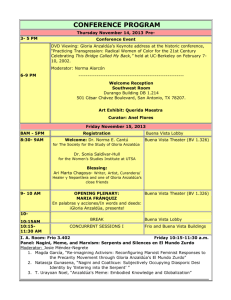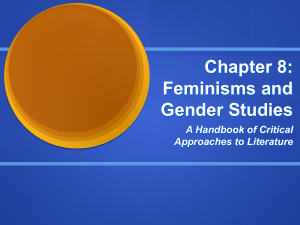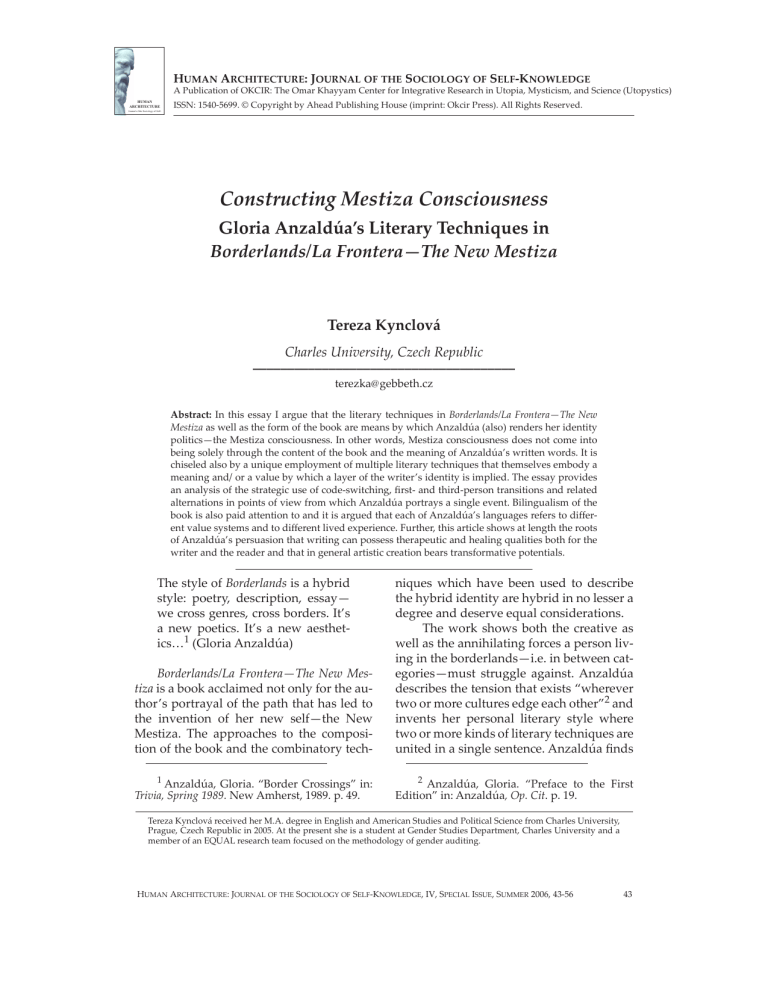
HUMAN ARCHITECTURE: JOURNAL OF THE SOCIOLOGY OF SELF-KNOWLEDGE
A Publication of OKCIR: The Omar Khayyam Center for Integrative Research in Utopia, Mysticism, and Science (Utopystics)
HUMAN
ARCHITECTURE
ISSN: 1540-5699. © Copyright by Ahead Publishing House (imprint: Okcir Press). All Rights Reserved.
Journal of the Sociology of Self-
Constructing Mestiza Consciousness
Gloria Anzaldúa’s Literary Techniques in
Borderlands/La Frontera—The New Mestiza
Tereza Kynclová
Charles University, Czech Republic
––––––––––––––––––––––––––––––––––––––
terezka@gebbeth.cz
Abstract: In this essay I argue that the literary techniques in Borderlands/La Frontera—The New
Mestiza as well as the form of the book are means by which Anzaldúa (also) renders her identity
politics—the Mestiza consciousness. In other words, Mestiza consciousness does not come into
being solely through the content of the book and the meaning of Anzaldúa’s written words. It is
chiseled also by a unique employment of multiple literary techniques that themselves embody a
meaning and/or a value by which a layer of the writer’s identity is implied. The essay provides
an analysis of the strategic use of code-switching, first- and third-person transitions and related
alternations in points of view from which Anzaldúa portrays a single event. Bilingualism of the
book is also paid attention to and it is argued that each of Anzaldúa’s languages refers to different value systems and to different lived experience. Further, this article shows at length the roots
of Anzaldúa’s persuasion that writing can possess therapeutic and healing qualities both for the
writer and the reader and that in general artistic creation bears transformative potentials.
Borderlands/La Frontera—The New Mestiza is a book acclaimed not only for the author’s portrayal of the path that has led to
the invention of her new self—the New
Mestiza. The approaches to the composition of the book and the combinatory tech-
niques which have been used to describe
the hybrid identity are hybrid in no lesser a
degree and deserve equal considerations.
The work shows both the creative as
well as the annihilating forces a person living in the borderlands—i.e. in between categories—must struggle against. Anzaldúa
describes the tension that exists “wherever
two or more cultures edge each other”2 and
invents her personal literary style where
two or more kinds of literary techniques are
united in a single sentence. Anzaldúa finds
1 Anzaldúa, Gloria. “Border Crossings” in:
Trivia, Spring 1989. New Amherst, 1989. p. 49.
2 Anzaldúa, Gloria. “Preface to the First
Edition” in: Anzaldúa, Op. Cit. p. 19.
The style of Borderlands is a hybrid
style: poetry, description, essay—
we cross genres, cross borders. It’s
a new poetics. It’s a new aesthetics…1 (Gloria Anzaldúa)
Tereza Kynclová received her M.A. degree in English and American Studies and Political Science from Charles University,
Prague, Czech Republic in 2005. At the present she is a student at Gender Studies Department, Charles University and a
member of an EQUAL research team focused on the methodology of gender auditing.
HUMAN ARCHITECTURE: JOURNAL OF THE SOCIOLOGY OF SELF-KNOWLEDGE, IV, SPECIAL ISSUE, SUMMER 2006, 43-56
43
44
TEREZA KYNCLOVÁ
herself continually at a quest for an adequate means of self-expression; a style
which would convey the internal hurt
caused by historical, political, social, and
also linguistic oppression and at the same
time would embody the language which
would perfectly fit her multiple identity—
Mestiza consciousness.
Anzaldúa is both the inheritor of the indigenous tradition and the bearer of the
Western academic thought which she has
obtained pursuing her university education. The authoress thus inosculates these
two contradictory approaches to language,
and the literary style of Borderlands/La
Frontera projects the writer’s attempt at
their mutual fusion and interconnectivity.
As Anzaldúa seeks a form of reconciliation of the two bordering cultures and her
double linguistic background to both of
which she belongs, she discovers a luculent
instrument: the solution dwells in writing
Borderlands/La Frontera bilingually.
Throughout the book the writer, gradually, composes a mosaic that in the end reveals a delicate new perspective for grasping the world’s reality, and of course, a new
approach to writing as such. Not only does
Anzaldúa challenge set definitions and categories of gender, ethnic and sexual identity, she also shatters the academic criteria a
piece of writing should obey. In an extraordinary way the authoress combines the old
with the modern—her native tongue and
ever-so flexible English. She also alternates
between first and third person narration,
which indicates her step-by-step growing
awareness of collective and individual
identity.
The experience Anzaldúa portrays can
thus be understood as both a representative
of Anzaldúa’s autobiography as an individual and at the same time as a representative
of the universal story of the Chicano people. The authoress confers on her writing:
“…the literature that [I] write is not just
about [my] experience; it’s a cultural representation…in Borderlands I am representing
the mestiza, the Chicana culture. I’m selfrepresenting it.”3 Thus one finds that the
listings of historical events in the book, involving the writer’s coming to terms with
her family’s life, are epitomes of universal
human experience. By such means Anzaldúa hopes that every individual can relate to her explication of the hybrid Mestiza
identity and embrace the cultural differences.
Further, as a writer, she defines herself
as a poet-shaman. She wants to heal herself
and her culture from diverse modes of suffering that affect Native American communities. Anzaldúa writes a confession of
someone who strives to preserve her cultural heritage and at the same time tries to
grasp the contradictions that are intrinsic to
the roots (and the self) which have sprung
up from the border culture, the “thin edge
of barbwire.”4
One who reads Anzaldúa’s Borderlands
is expected to look for the message of the
book beyond the printed words. The reader
must rely on intuitive understanding; an
unconscious link to the work will be born
once the reader frees himself/herself from
the conventional deciphering of the text. As
the author’s mixture of English and Spanish is spontaneous so is expected to be the
reader—unbound and willing to accept all
shifts in style and form as well as the emotions that the book arouses in him/her.
BORDERLANDS’ HYBRID STYLE:
MIXING GENRES
To meet her goal in the readers, Anzaldúa utilizes numerous literary techniques and grants her book a special, flamboyant composition. The writing floats
above the two main languages as well as
above the styles used. Prose mingles with
3 Anzaldúa, Gloria. “Border Crossings” in:
Trivia, Spring 1989. New Amherst, 1989. p. 47,
(emphasis hers).
4 Anzaldúa, Op. Cit. p. 25.
HUMAN ARCHITECTURE: JOURNAL OF THE SOCIOLOGY OF SELF-KNOWLEDGE, IV, SPECIAL ISSUE, SUMMER 2006
CONSTRUCTING MESTIZA CONSCIOUSNESS
poetry, English with Spanish, essays with
autohistorías, history with myths. This is
what Anzaldúa says about Borderlands/La
Frontera in the fifth chapter of the book:
This…product [of writing] seems
an assemblage, a montage, a beaded work with several leitmotifs
and with a central core, now appearing, now disappearing in a
crazy dance. The whole thing has
had a mind of its own, escaping me
and insisting on putting together
the pieces of its own puzzle with
minimal direction from my will. It
is a rebellious, willful entity…for
me it is alive, infused with spirit. I
talk to it; it talks to me.5
The question then becomes evident:
can Anzaldúa succeed in delivering a comprehensive message when the book’s ‘scaffolding’6 is not anchored in any pre-scribed
category and the book aims to challenge
given academic rules for writing? I believe
so.
Having liberated herself from the academically dictated style of prose- and poetry-writing, she achieves a goal of unrestricted expression which both conveys and
embodies the author’s message and is the
utter representation of freedom. Below I explain the methods of literary techniques
employment that make meeting Anzaldúa’s objectives possible.
The composition of Anzaldúa’s Borderlands/La Frontera openly acknowledges the
Aztec mosaic-like pattern of writing. The
Aztec codices were painted with red and
black ink, the colors alternating one with
another. The intertwined design of these
5 Ibid., p. 89-89.
6 Ibid., p. 88. References to the structuring of
the book often carry allusions to human physiology (such as: “If I can get the bone structure right,
then putting flesh on it proceeds without too many
hitches.”). Here scaffolding refers to “the deep
structure [of the text].”
45
two colors symbolized wisdom and writing. The ancient Aztec civilization maintained that communication with the Divine
Deities could be attained through the power of “metaphor and symbol, by means of
poetry and truth.” The two colors’ continual emergence, disappearance and re-emergence anew again indicated a “thick-here,
thick- there” pattern that suggested weaving motions.7
The interwoven variations in styles and
genres are typical for the writing technique
Anzaldúa has taken up in Borderlands and it
is analogous to the weaving pattern of
emergence/disappearance
approached
above. Anzaldúa thus explicitly manifests
her affinity to the written heritage of her
distant Aztec ancestry. Despite this historical connotation, her text and the style in
which it is composed differ radically in its
purpose from the old-time indigenous codices. Besides abrupt transitions from lecture-like essays on history and/or anthropology as well as aesthetics and sociology,
sections written in prose are interlaced with
poetry which crops up suddenly, as if unexpectedly. Yet, Anzaldúa argues, poetry’s capacity for delivering meanings equals that
of ‘high theory’—what she calls established
academic practices.
Anzaldúa’s masterpiece does truly
transcend existing theoretical rules of text
composition as well as challenges the literary canon of the Anglo-American academy.
Borderlands’ aim is to enunciate the writer’s
struggle for her (and Chicano people’s) cultural legacy and, at the same time, demonstrate her endeavor to “change composition, the way people write…because life is
a permanent resistance against the status
quo, the political climate, and against the
academic standards of the different disciplines.”8
Why does the authoress refuse to obey
given academic doctrines and why does
she insist on shaping a theory of her own?
7 Ibid.,
p. 91.
HUMAN ARCHITECTURE: JOURNAL OF THE SOCIOLOGY OF SELF-KNOWLEDGE, IV, SPECIAL ISSUE, SUMMER 2006
46
TEREZA KYNCLOVÁ
First, the entire concept of Mestiza consciousness illustrates the fluidity of the self
that is founded on self-invented values and
laws. The book, therefore, reflects this independence-oriented Mestiza philosophy
and ‘behaves’ accordingly. In other words,
the writing style embodies a mirror image
of the unbridled, limit-free Mestiza consciousness; Borderlands is a materialization
of Anzaldúa’s mental construction of the
personal (and collective) identity.
Second, the authoress disputes Western academy-derived theory for she finds it
restraining and also ignorant of her position of a marginalized writer. She contests
the deletion by the dominant culture from a
socially inferior standing. This position
serves as an impulse that consequently provides soil for an alternative type of theory
construction. Hector A. Torres argues that
under an imperative of this sort “the minority writer produces a theory that is much
more readable but not any less rigorous,
precisely because the ‘fit’ between fact and
theory, description and explanation, life
and text is more immediate in terms of the
political context in which that theory or explanation is written.”9
By contrast, the official or ‘high theory’
that proceeds from the educational establishment employs exclusively abstract language and focuses on objectivity. Any autobiographical details are expunged from the
academic text. Also contemporary theory is
highly specialized and routinely involves
sophisticated terms, specific-meaning systems, and complex, intertextual references.
This results in a division of the reader- and
writer-communities and may cause an
abysmal discrepancy between the insider/
outsider knowledge which implies potential impediment to social and/or economic
advancement.10
Anzaldúa is convinced that professional jargon as well as abstract theorizing can
worsen the writer-reader communication
and lead to mutual alienation. Anzaldúa
goes against the fixed genres and produces
writing which is to be personal and accessible to all readers. She constructs a theoretical framework of her own which enables
her to articulate the lived experience of a
minority writer: she makes an attempt to
translate what would normally be a dense,
theoretical writing into practical terms
which have the ability to convey the experiences of self-identified women, lesbians,
and other previously ignored minorities.11
Writing, for Anzaldúa, possesses transformative powers. So does theory. Keating
writes that conventional theories and belief
systems often “contain hidden biases privileging restrictive gender, ethnic, sexual,
and class norms” and that it is vital people
find open political theories that “simultaneously expose these hidden biases and offer alternative perspectives.”12 This view
sums up the purport of Anzaldúa’s theory.
The following lines in Anzaldúa’s own
words summarize her call for new types of
theories that re-interpret and revise existing belief systems. Anzaldúa’s aims to correlate Borderlands/La Frontera with her theory:
8 Ikas, Karin Rosa. “Gloria Anzaldúa: Writer, Editor, Critic, and Third-World Lesbian
Women-of-Color Feminist” in: Ikas, Karin, ed.
Chicana Ways: Conversations with Ten Chicana
Writers. Las Vegas: University of Nevada Press,
2002. p. 6.
9 Torres, Hector A. “In Context: Gloria Anzaldúa’s Borderlands/ La Frontera: The New
Mestiza” in: Braum, Harold Augen and Olmos,
Margarite Fernndez, ed. U.S. Latino Literature: A
Critical Guide for Students and Teachers. New
York: Greenwood Press, 2000. p. 124, (emphasis
his).
Theory produces effects that
change people and the way they
perceive the world. Thus we need
teorías that will enable us to inter10 Keating, AnaLouise. Women Reading
Women Writing: Self-Invention in Paula Gunn
Allen, Gloria Anzaldúa and Audre Lorde. Philadelphia: Temple University Press, 1996. p. 10.
11 Ibid., p. 11.
12 Ibid., p. 11-12.
HUMAN ARCHITECTURE: JOURNAL OF THE SOCIOLOGY OF SELF-KNOWLEDGE, IV, SPECIAL ISSUE, SUMMER 2006
CONSTRUCTING MESTIZA CONSCIOUSNESS
pret what happens in the world,
that will explain how and why we
relate to certain people in specific
ways, that will reflect what goes on
between inner, outer and peripheral “I”’s within a person and between the personal “I”’s and the
collective “we” of our ethnic communities. Necessitamos teorías that
will rewrite history using race,
class, gender and ethnicity as categories of analysis, theories that
cross borders, that blur boundaries—new kind of theories with
new theorizing methods.13
The book’s hybrid form illustrates Anzaldúa’s new theorizing methods through
the weaving pattern applied to the writing
process: autobiography precedes historical
narrative which is followed by poetry—
which, in Borderlands, is highly autobiographical. Further, the shifts in genres are
supported by shifts in registers and switching across her English, Spanish, and other
languages.
To provide evidence for the hybrid
style of the book, one may focus, for example, on the opening chapter of Borderlands/
La Frontera titled “The Homeland, Aztlán:
El otro México.” It commences with a Mexican poem, then a brief introduction on the
indigenous people unfolds in a sociological
and geographical essayist style. An extensive poem written in both English and
Spanish follows portraying the ambiguities
of life on the U.S./Mexican border. The
genre used for the description of the situation in the Rio Grande region then alters: an
essay ensues. A depiction of an autobiographical experience with the migrant people is included next to be subsequently sustained by historical data. Thus various
genres and different languages form the
Aztec weaving pattern of writing which is
13 Anzaldúa, Gloria. “Preface” in: G. Anzaldúa, ed. Op. Cit. p. xxv.
47
the pervasive compositional strategy of the
book. Diane Freedman argues that Anzaldúa’s writing from and through borders
“results in an unbounded fecundity, a powerful, poetic hybrid where the personal, poetic and political are joined…[It is] a self-expressive literature of mosaics and margins
[which] defy dominant culture’s ‘voice of
order.’”14
EXPERIENCING THE WRITING
PROCESS: THE SHAMANISTIC AND
HEALING QUALITIES OF WRITING
For silence to transform into
speech, sounds and words, it must
first traverse through our female
bodies.15 (Gloria Anzaldúa)
Anzaldúa is persuaded that the female
body is a gateway through which a woman
can access her language. The epigraph
above indicates the central position female
corporality attains in women’s political assertion of the right to voice their overlooked subordinate standing within the society and culture. Anzaldúa’s focus is on
dismissing the compulsory tradition of silence that has cornered women in minority
cultures through the cultural, sexual and
linguistic oppressions. She believes that
creative processes—especially writing—
possess such transformative powers that
not only women’s identity but also their
immediate reality may witness a profound
change. By writing, an authoress can gain a
14 Freedman, Diane P. “Writing in the Borderlands: The Poetic Prose of Gloria Anzaldúa
and Susan Griffin” in: Perry, Linda M., Turner,
Lynn and Sterk, Helen, ed. Constructing and Reconstructing Gender: The Links Among Communication, Language and Gender. Albany: State
University of New York Press, 1992. p. 211, (emphasis hers, parenthesis mine).
15 Anzaldúa, Gloria. “Preface” in: Anzaldúa, Gloria, ed. Making Face Making Soul: Haciendo Caras: Creative and Critical Perspectives by
Feminists of Color. San Francisco: Aunt Lute
Books, 1990. p.xxii.
HUMAN ARCHITECTURE: JOURNAL OF THE SOCIOLOGY OF SELF-KNOWLEDGE, IV, SPECIAL ISSUE, SUMMER 2006
48
TEREZA KYNCLOVÁ
thorough perspective of her inner self, can
achieve autonomy and most importantly,
can discover how the dominant culture has
devalued her personality.
Throughout all her work, Anzaldúa
shows how women’s potential of developing self-affirmative forms of expression,
such as speaking and writing, has been inhibited by the Western culture’s favoring of
the masculine. As a result, a woman is defined by male desire and “the female body
has been objectified, appropriated, marginalized and repressed in and by phallocentric language systems.”16
This significantly influences women’s
view of themselves; any reference to their
selves as well as their identity and sensuality is inevitably carried out in accordance
with the male-defined standards. The absence of female-identified language violates women’s ability to word their utter experience in a satisfactory way, i.e. in a manner that would fully correspond and reflect
females’ experience and at the same time
would not hinder their attempt at expressing themselves totally. “It is difficult to
speak from/through our bodies because
they have been stolen, brutalized or
numbed,” argues Anzaldúa in a preface to
Making Face, Making Soul/Haciendo Caras.17
The path to discovering an adequate
modus of female-oriented discourse bears
no insurmountable obstacles for women.
They must, so urges Anzaldúa, reclaim
their stolen bodies and let their embodied
experience resonate through their flesh.
“It’s not on paper that you create but in
your innards, in the gut and out of living
tissue—organic writing, I call it,” says the
writer.18 To Anzaldúa, body and text are
16 Keating, Op. Cit. p.118.
17 Anzaldúa, Gloria. “Preface”
in: G. Anzaldúa, ed. Op. Cit. p. xxii.
18 Anzaldúa, Gloria. “Speaking in Tongues:
A Letter to 3rd World Women Writers” n: Anzaldúa, Gloria and Moraga, Cherrie, ed. This
Bridge Called My Back: Writings by Radical Women
of Color. New York: Kitchen Table: Women of
Color Press, 1983. p. 172.
one.
AnaLouise Keating implies that women’s body-writing can mediate new forms
of knowledge because such creation employs resources that cannot be controlled,
not even by the writer herself. The bodily
component used in the quest for comprehension of their selves alters women’s view
of their bodies. The female body (and a
woman too) should no longer be understood as the other, as the stranger, as “the
one closer to the undivine.”19 Women
should learn to value and recognize the carnal within their experience and their writing should reflect this new dimension.
It is generally believed that females
tend to perceive their experience through
emotions, as well as through intuition and
instincts. These irrational components of
grasping the reality have been disparaged
by the hegemony of Cartesian knowledge
that elevates the conceptual approach to
the world over the corporeal; in other
words, it denies the feminine knowledge its
validity. Therefore, as Keating speaks of the
possibility of inventing a new, nonphallic,
kind of knowledge, “the development of female-identified voices, bodies and texts
breaks apart this [Cartesian] gendered binary structure, providing [thus] a significant challenge to existing knowledge systems.”20
Anzaldúa believes that culture can be
changed from within because body-writing
grants self-identified women new tactics
for political intervention and social change.
Anzaldúa’s female writer, a mujer magica,
acquires through her body new modes of
perception and then transmits these into
her actions.
Abstract thought and the guidance of
academic erudition are, in Anzaldúa’s Mestiza view, no significant factors in literary
creation; on the very contrary, she encourages oppressed women of color to dispose
19 Anzaldúa, Op. Cit. p. 39.
20 Keating, Op. Cit. p.119.
HUMAN ARCHITECTURE: JOURNAL OF THE SOCIOLOGY OF SELF-KNOWLEDGE, IV, SPECIAL ISSUE, SUMMER 2006
CONSTRUCTING MESTIZA CONSCIOUSNESS
of the norms indoctrinated by Western culture’s educational system and produce
writing free of any pre-constructed tenets.
“Throw away abstraction and the academic
learning, the rules, the map and compass.
Feel your way without blinders. To touch
more people, the personal realities and the
social must be evoked—not through rhetoric but through blood and pus and
sweat.”21
In putting such a stringent emphasis on
the inclusion of materiality in the creating
process, Anzaldúa forbears, however, a major constituent of writing; she neglects the
quality of the literary piece. Excluding the
academic restrictions from the process of
creation does not necessarily imply an alleviation of the artistic value of a work. Yet,
the aesthetics of the writing and its quality
do not seem to be Anzaldúa’s main objective.
Nonetheless, in the interview22 with
Karin Ikas, Anzaldúa does admit that the
reader’s response is important to her and
therefore she must strive for aesthetic qualities in her books and—since she resists all
prescribed theoretical limitations—maneuver between what is still acceptable to the
readers and what goes beyond.
Anzaldúa’s overriding of the artistic
qualities as comprehended by the Western
culture has two motives that are closely
linked:
First, indigenous people never separate aesthetic qualities of a piece of art from
its religious, social and/or functional purposes. Creation for mastery’s sake leads to
the objectification of the work, which is a
trait representative of the Western culture,
argues Anzaldúa. She refers to her Indian
past and thus on purpose dismisses the dictate of the Western aesthetics. She wishes to
treat a work of art “not just as an object but
21 Anzaldúa, Gloria. “Speaking in Tongues:
A Letter to 3rd World Women Writers” in: Anzaldúa, Gloria and Moraga, Cherrie, ed. Op. Cit.
p. 173.
22 Ikas, Op. Cit. p. 7.
49
also as a person.” To her, the value of a
piece of art lies in the energy it can radiate
and the live and active powers it carries.
These powers have the capacity to initiate a
change not only in the observer (or a reader) but also in the artist (writer) herself.
Such art is “dedicated to the validation of
humans.”23 Writing can perform a change.
Second, Anzaldúa ascribes healing
traits to the process of writing. This feature
seems to have been the principal impetus
for her literary as well as theoretical accomplishment. The authoress associates the
writer with the shaman and the purpose of
writing is then made obvious: finding a
cure for the residues of trauma faced by an
oppressed woman. The medicine is to be
looked for within the female body which is
burdened with the traumatic experience.
The writing process represents the healing
agent through which the medicine is then
administered. The quality of a piece of writing lies first of all in its therapeutic potential. The aesthetic content, so enforced in
the Western arts, is in Anzaldúa’s perspective secondary.
The metaphorical analogy of a writer
being a shaman is the central and most important notion in Anzaldúa’s literary
works; it is a topic which Anzaldúa never
allows to pass unmentioned in her essays
on literary production. An essay which explicitly deals with the shaman-writer parallel was published after first theoretical reactions to Borderlands/La Frontera appeared. In
“Metaphors in the Tradition of the Shaman,” Anzaldúa re-conceptualizes Aztec
metaphysical beliefs that used to be associated with the shaman’s role within the indigenous society. The authoress transfers
the ancient shamanistic tradition into the
present situation and incorporates the idea
into her theoretical thought.
The shaman—the Aztec nahual—was to
preserve and create the cultural or the communal identity and function as a mediator
23 Anzaldúa,
Op. Cit. p. 89-90.
HUMAN ARCHITECTURE: JOURNAL OF THE SOCIOLOGY OF SELF-KNOWLEDGE, IV, SPECIAL ISSUE, SUMMER 2006
50
TEREZA KYNCLOVÁ
between the cultural heritage of the past
and present. Nowadays, Anzaldúa employs the shamanistic features in her Mestiza-consciousness-defined aesthetics. Further she argues, in Keating’s words, that
“tribal cultures’ shamanistic traditions represent the development of sophisticated,
well-integrated aesthetic, religious, and political systems,” and thus seeks to shatter
the Western culture’s approach to these
practices as pagan, superstition-based
cults.24
How does Gloria Anzaldúa then use
the shamanistic metaphor in her works? In
the beginning of Anzaldúa’s writing, there
must be an upsetting and/or painful emotion emitted from within her body; from
this impulse, unconsciously, an image is derived. Since an image is “more direct and
more immediate than words,” it bridges
the gap between the evoked feeling and
knowledge. Afterwards, the sensation is
verbalized: “picture language precedes
thinking in words; the metaphorical mind
precedes analytical consciousness.”25
It has been argued that for Anzaldúa
the body is a fundamental agent present in
the process of writing and that writing, being a shamanistic endeavor, is expected to
release healing powers. Therefore it follows
that the impulses that force Anzaldúa to
write involve intense physical and psychic
pain—essential ingredients in the writing
experience.
In order to gain the ability to see the
way in which the healing nahual has been
built into Borderlands/La Frontera, one must
decipher the three components of the overall ‘medical’ treatment:
First, Anzaldúa strives to understand
the origins of an ‘illness’ and the pattern in
which it “unbalances a person or a community” and spreads as “a form of disease, or
disinformation/misinformation perpetrated on women and people of color.” Second,
24 Keating, Op. Cit. p.135.
25 Anzaldúa, Op.Cit. p. 91.
Anzaldúa searches for the cure that “leads
to a change in the belief system.” Third, she
acknowledges the healer: integrating the
tradition of the shaman into her writing allows Anzaldúa to take the advantage of the
performative effects of language. Thus not
only can she reinvent her personal identity
but she can also reinvent her immediate reality and that of her readers as well.26
An even more self-explanatory parallel
to the therapeutic service the book Borderlands/La Frontera embodies can be offered:
the ‘illness’ to be treated is represented by
“una herida abierta, the 1,950 mile-long
open wound dividing a pueblo.” In other
words, the U.S./Mexican border is the disease. Relief or cure can be achieved through
writing the body and the soul, i.e. through
inventing the New Mestiza. The doctor is
the authoress herself; “writing heals me
[and] brings me great joy.” 27
Although writing delivers an improvement in the physical and/or psychic state,
Anzaldúa compares the writing process to
undergoing an immense danger; a mental
barrier that must be overcome. The creative
process, to Anzaldúa, represents a source of
anxiety for she never knows what depths of
her self she might uncover. “To write is to
confront one’s demons, look them in the
face and live to write about them…yet, in
that very act lies our survival because a
woman who writes has power.”28
26 Anzaldúa, Gloria. “Metaphors in the Tradition of the Shaman” in: Conversant Essays: Contemporary Poets on Poetry. Detroit: Wayne State
University Press, 1990. p. 99. This essay was
published eight months after Borderlands/La
Frontera “hit the bookstores.” For more on the
shamanistic tradition in Anzaldúa see: Steele,
Cassie Premo. We Heal from Memory: Sexton,
Lorde, Anzaldúa, and the Poetry of Witness. New
York: Palgrave, 2000, p. 86-90.
27 Anzaldúa, Op. Cit. p. 24-25 and 92.
28 Anzaldúa, Gloria. “Speaking in Tongues:
A Letter to 3rd World Women Writers” in: Anzaldúa, G. and Moraga, C., ed. Op. Cit. p. 171.
HUMAN ARCHITECTURE: JOURNAL OF THE SOCIOLOGY OF SELF-KNOWLEDGE, IV, SPECIAL ISSUE, SUMMER 2006
CONSTRUCTING MESTIZA CONSCIOUSNESS
CODE-SWITCHING
Earlier in this essay I have demonstrated that Anzaldúa’s style is one of a medley
of genres: the text of Borderlands is interspersed with prose and verse, autobiographical testimonials shift to academic essays on history, legends and myth-making
go hand in hand. The genre of the book continually resists stasis. Such an intentional
design thus transgresses the standard conventions of literary production for Anzaldúa strives to vanquish the limitations
set by literary theory in her quest for ideal
means of expression and conveyance of the
Mestiza philosophy.
Lois Zamora is highly supportive of
Anzaldúa’s style-blending that contributes
to the perfection of Borderlands’ message:
[Anzaldúa] con/fuses the complementary impulses to record and to
imagine, creating brilliant mixtures
of myth, history, and the remembered past…[where] autobiography and fiction naturally overlap
and invade each other’s usual territory…It is a matter of finding a
voice or style that does not violate
one’s several components of identity.29
Multiple identity, multiple genres.
There is, however, another element in Anzaldúa’s Borderlands that can be invested
with the adjective ‘multiple’ and that is the
optics of the writer. In other words, Anzaldúa has taken advantage of her placement between borders: she has been searching for both her selfhood and culture within the dominant Anglo society as well as
within the marginalized Chicano commu29
Zamora, Lois Parkinson. “Introduction:
Moveable Boundaries—Public Definitions and
Private Lives” in: Zamora, Lois Parkinson, ed.
Contemporary American Women Writers: Gender,
Class, Ethnicity. New York: Longman, 1998. p. 6,
(parenthesis mine).
51
nity. Having operated along these moveable boundaries, Anzaldúa is infused with
an alternative insight—or the Coatlicue state
as she calls it. It is a ‘rupture in everyday
sensing.’30 The authoress therefore possesses a capacity of innovative viewing and interpreting her immediate reality.
How does she transmit the multiplicity
of her perspective via the text? What tools
does she employ? Code-switching, besides
variations in genre, is another technique
the authoress deploys in order to convey
the philosophy of the Mestiza and to heal
from her oppressed and underprivileged
past.
In Borderlands there are two models according to which the technique of switching codes can be analyzed. First, it involves
switching between English and Spanish
(and other of Anzaldúa’s reclaimed languages). Second, it pertains to abrupt shifts
between first and third person narration.
For an oppressed Mestiza dwelling in
the region of a dividing line, the ability to
speak in many tongues becomes the primary survival mechanism. Linda Nelson furthers this idea: “Switching codes, switching
languages, is necessary when the dominant
culture insists on one language, one color,
two genders, one sexuality.”31
Anzaldúa makes transitions from
taught standard English to acquired working-class English to native Chicano Spanish
or to Tex-Mex. She frequently does so even
in the middle of a sentence or a poem, thus
claiming all languages as equal. Yet, each of
the languages is used for different occasions; each refers to a different culture and
portrays different events. Each language
also implies a different value system. From
the mutual combination of the languages
30 Anzaldúa, Op. Cit. p. 68.
31 Nelson, Linda. “After Reading:
Borderlands/La Frontera” in: Trivia. New Amherst:
Spring 1989, p. 95. For more on code-switching
see also: Steele, Cassie Premo. We Heal from
Memory: Sexton, Lorde, Anzaldúa, and the Poetry of
Witness. New York: Palgrave, 2000, p. 52.
HUMAN ARCHITECTURE: JOURNAL OF THE SOCIOLOGY OF SELF-KNOWLEDGE, IV, SPECIAL ISSUE, SUMMER 2006
52
TEREZA KYNCLOVÁ
deployed in Borderlands a ‘borderland language’ emerges. In the preface to the second edition Anzaldúa claims:
The switching of codes in this book
from English to Castilian Spanish
to the North Mexican dialect to
Tex-Mex to a sprinkling of Nahuatl
to a mixture of all of these, reflects
my language, a new language—the
language of the Borderlands. There
at the juncture of cultures, languages cross-pollinate and are revitalized; they die and are born.32
In Borderlands Chicano Spanish is mostly used in the depiction of emotional distress or when a special emphasis is put on
historical facts that entail the cultural oppression of all indigenous people and/or
Chicanos/Chicanas. Cultural terminology
is solely referred to in Chicano Spanish e.g.
maquiladoras—factories owned by American conglomerates where especially Mexican immigrants are employed and paid
minimal wages; pocho—an anglicized Spanish-speaking Mexican whose accent is characteristic of North Americans and who distorts his Spanish under the influence of English;
mojados—“wetbacks,”
Mexican
immigrants who reached the U.S. by having waded through the Rio Grande from del
otro lao—the other side, a term Chicanos
use when referring to that part of their
homeland which is governed by Mexico.33
To illustrate the differentiated treatment English and Chicano Spanish are given and the hidden meanings these languages can contain, an example can be traced in
the second chapter “Movimientos de rebeldía y las culturas que traicionan”
(Movements of Rebellion and Cultures
That Betray). The chapter opens with a
lengthy passage that questions the domi32 Anzaldúa,
33 Anzaldúa,
Op. Cit. p. 20.
Op. Cit. p. 32, 33, 78. Chicanos
tend to drop the ‘d’ vowel in some Spanish
words, for instance in ‘lado’ as spelled above.
nant position of men over women within
the Chicano community; a cultural trait
that Anzaldúa radically dismisses. The
writer chronicles her increasing awareness
of the cultural hindrances that are posed in
front of her (and other Chicanas) as she is
coming of age: through the initial obedience and silent acceptance a rebellion surfaces. “I have grown. I no longer spend my
life dumping cultural customs and values
that have betrayed me. I have also gathered
time proven customs…that respect women.”34
The section is written in un-translated
Chicano Spanish and as Saldívar-Hull suggests, “serves as a proclamation of independence for the mestizas bound within a
male-dominated culture.”35 Intentionally,
the passage addresses the Chicano men
and male-identified women—those who
help to keep alive the oppressive traditions
that circulate continually in the community—in Spanish. Anzaldúa’s use of the native tongue implies a speech towards the
tribe’s elders—the bearers of wisdom and
knowledge who have the power of reshaping the rules of the community and who
might thus better comprehend the speaker’s (writer’s) concerns. The declaration,
however, ends in English—the dominant
culture’s language which at the same time
is the language of Anzaldúa’s feminist assertion and the language in which the Mestiza philosophy is formulated. Anzaldúa’s
bilingual strategy may denote her plan to
confront the Chicano representatives in the
language intrinsic to her cultural tradition,
although they certainly may be fluent English speakers.36
The title of Borderlands/La Frontera—The
New Mestiza itself, being partly English and
34
Anzaldúa, Op.Cit. p. 37, (translation by
Sonia Saldvar-Hull).
35 Saldvar-Hull, Sonia. “Introduction to the
Second Edition” in: Anzaldúa, Op.Cit. p. 3-4.
Saldvar-Hull provides a translation of the passage discussed.
36 Ibid., p. 3-4.
HUMAN ARCHITECTURE: JOURNAL OF THE SOCIOLOGY OF SELF-KNOWLEDGE, IV, SPECIAL ISSUE, SUMMER 2006
CONSTRUCTING MESTIZA CONSCIOUSNESS
partly Spanish, suggests a notion of a dividing line; both the book and its language
contain a collection of opposites, counterparts and ambiguities. To find the true
meaning of Anzaldúa’s words and ideas
one has to read between the lines knowing
that every line, at least optically, represents
another border. Does Anzaldúa succeeds in
explicating her identity-politics to her readership even though her ‘borderlands
tongue’ involves mainly Germanic and Romance languages, both of which sprang up
from different traditions?
A reader who does not speak Spanish
may possibly find himself/herself at the
very same loss that Anzaldúa, as a representative of a misunderstood and marginalized people, faces on regular basis. By
having mingled the two languages, Anzaldúa literally forces her readers to undergo an experiment:
First, they witness the shared Chicano
experience of perpetual miscomprehension
of their cultural heritage which the dominant culture fails to recognize as appealing
or at least as justified in its search for roots.
Second, Spanish non-speakers also endure the potential frustration suffered by
the Chicano people that must have followed instantaneously after the U.S. annexation of the Aztlán territory: the Mexican
mestizos did not then speak English.
Nevertheless, such readers’ inability to
understand all of Anzaldúa’s words does
not necessarily impair the writer’s attempt
at conveying her experience in an effective,
although unique, manner. The authoress
has simply avoided linguistic means in the
portrayal of her lived experience and has
rather created a genuine sensation of a notbeing-understood feeling directly in her
readers. In other words, Anzaldúa teaches
her readers by exerted and individuallylived, therefore active, perception that is being imposed on the audience while reading
Borderlands; she does not use conventional
demonstrative and/or narrative methods
which do not encourage the readers to par-
53
ticipate actively in experiencing the writing
in such an extensive degree as the strategy
employed.
Gloria Anzaldúa thus re-creates her
readership as she forces her audience,
along with herself, to question the dominant culture’s practices and as she enlivens
her personal experience in her readers. Anzaldúa’s numerous passages on writing
contained in the book express her belief,
that writing, as well as reading, are influential creative processes that significantly influence the artist’s and the readership’s
psyches and bodies. The border between
the creator and the targeted recipient of the
message is then dissolved—both sides
share a mutual commonality: they are affected by the work and possibly changed.
As Monika Kaup writes of Anzaldúa’s narrative strategy: “It is to combine and entangle subject and object positions in cultural
narration, a style that does away with
closed-off, bordered positions of neutral
knowers and of cultural actors.”37 In Anzaldúa’s view artistic creation is not a mere
materialization of ideas; it is above all a
mental and physical experience which carries therapeutic qualities.
Having explicated the first type of
code-switching, i.e., the alternation of English and Spanish, let us proceed to the second technique: shifts in first and third person narration.
Changes in the perspective from which
she speaks in the work enable Anzaldúa to
record the simultaneous shaping of both
her personal as well as collective identity:
of a self-defined Anzaldúa as a mestiza ‘living’ her self-invented Mestiza consciousness, i.e. multiple, all-embracing, evershifting identity; and of Anzaldúa defined
37
Kaup, Monika.“Crossing Borders: An
Aesthetic Practice in Writings by Gloria Anzaldúa” in: Siemerling, Winfried and Schwenk,
Katrin, ed. Cultural Difference & the Literary Text;
Pluralism & the Limits of Authenticity in North
American Literatures. Iowa City: University of
Iowa Press, 1996. p. 106.
HUMAN ARCHITECTURE: JOURNAL OF THE SOCIOLOGY OF SELF-KNOWLEDGE, IV, SPECIAL ISSUE, SUMMER 2006
54
TEREZA KYNCLOVÁ
by Western terms as a queer, lesbian, woman-of-color writer/poet/critic, a member of
the underprivileged Chicano ethnic group
and a graduate of an American university
who acknowledges her multiple cultural
roots.
By shifting first and third person narration the writer places herself in the role of a
speaker voicing concerns of multitudes—
sexual, racial, cultural minorities. The authoress says about her masterpiece:
woman commonly becomes a prey of victimization. Risking her health, this economic refugee “leaves the familiar and safe
homeground to venture into unknown and
possibly dangerous terrain.”39 Thus Anzaldúa’s poem from the beginning of the
chapter changes in the final lines:
I don’t feel that I, Gloria, produced
Borderlands all by myself. I just happen to be the mouthpiece, the
channel. While I do feel that the images and words…the way that I
speak…the structure and style are
mine, I found the raw material out
there in the world, in other people’s experiences, and in books.38
No longer does Anzaldúa narrate her
personal story. Replacing “my” with “her”
implies the writer’s acceptance of a multiple voice and also her identification with
the doomed experience of the oppressed
woman.
Moreover, this “her” does not refer to
the story of the above described illegal trespasser solely. “She” is a vicarious embodiment of all oppressed and marginalized
women whose experiences Anzaldúa aims
to ventilate and incorporate within a liberating principle—the Mestiza consciousness.
How does Anzaldúa employ this codeswitching technique in the book? Let me
provide an example. In the first chapter the
opening poem on geography and history of
the troubled Rio Grande border includes a
stanza describing Anzaldúa’s painful balancing on the dividing line. The authoress
writes:
This is my home
this thin edge of
barbwire.
Having introduced the general, textbook-like history of the region, Anzaldúa
directs her attention to the overlooked—to
people whose fates are not catalogued in
any official version of history. The closing
paragraphs of the chapter describe the economic exploitation of a representative female refugee la mojada, la mujer indocumentada as she seeks to support her Mexican
family by working illegally in the U.S. Being threatened with deportation, such a
38 Torres,
Op. Cit. P. 125.
This is her home
this thin edge of
barbwire.
REFERENCES:
Anzaldúa, Gloria. Borderlands/La Frontera-The
New Mestiza. San Francisco: Aunt Lute
Books, Second Edition, 1999.
Anzaldúa, Gloria. “Border Crossings” in: Trivia,
Spring 1989. New Amherst, 1989.
Anzaldúa, Gloria. “Preface” in: Anzaldúa, Gloria, ed. Making Face Making Soul: Haciendo
Caras: Creative and Critical Perspectives by
Feminists of Color. San Francisco: Aunt
Lute Books, 1990.
Anzaldúa, Gloria. “En rapport, In Opposition:
Cobrando cuentas a las nuestras” in:
Anzaldúa, Gloria, ed. Making Face Making
Soul: Haciendo Caras: Creative and Critical
Perspectives by Feminists of Color. San
Francisco: Aunt Lute Books, 1990.
Anzaldúa, Gloria. “Speaking in Tongues: A Let39 Anzaldúa, Op. Cit. p. 35. Poems quoted
from p. 25 and p. 35.
HUMAN ARCHITECTURE: JOURNAL OF THE SOCIOLOGY OF SELF-KNOWLEDGE, IV, SPECIAL ISSUE, SUMMER 2006
CONSTRUCTING MESTIZA CONSCIOUSNESS
ter to 3rd World Women Writers” in:
Anzaldúa, Gloria and Moraga, Cherrie,
ed. This Bridge Called My Back: Writings by
Radical Women of Color. New York:
Kitchen Table: Women of Color Press,
1983.
Anzaldúa, Gloria. “Metaphors in the Tradition
of the Shaman” in: Conversant Essays:
Contemporary Poets on Poetry. Detroit:
Wayne State University Press, 1990.
Freedman, Diane P. “Writing in the Borderlands: The Poetic Prose of Gloria
Anzaldúa and Susan Griffin” in: Perry,
Linda M., Turner, Lynn and Sterk, Helen,
ed. Constructing and Reconstructing Gender: The Links Among Communication, Language and Gender. Albany: State
University of New York Press, 1992.
Ikas, Karin Rosa. “Gloria Anzaldúa: Writer, Editor, Critic, and Third-World Lesbian
Women-of-Color Feminist” in: Ikas,
Karin, ed. Chicana Ways: Conversations
with Ten Chicana Writers. Las Vegas: University of Nevada Press, 2002.
Kaup, Monika. “Crossing Borders: An Aesthetic
Practice in Writings by Gloria Anzaldúa”
in: Siemerling, Winfried and Schwenk,
Katrin, ed. Cultural Difference & the Literary Text; Pluralism & the Limits of Authenticity in North American Literatures. Iowa
City: University of Iowa Press, 1996.
Keating, AnaLouise. Women Reading Women
Writing: Self-Invention in Paula Gunn
Allen, Gloria Anzaldúa and Audre Lorde.
Philadelphia: Temple University Press,
1996.
Nelson, Linda. “After Reading: Borderlands/La
Frontera” in: Trivia, Spring 1989. New
Amherst, 1989.
Saldívar-Hull, Sonia. “Introduction to the Second Edition” in: Anzaldúa, Gloria. Borderlands/La Frontera-The New Mestiza. San
Francisco: Aunt Lute Books, Second Edition, 1999.
Torres, Hector A. “In Context: Gloria
Anzaldúa’s Borderlands/ La Frontera:
The New Mestiza” in: Braum, Harold
Augen and Olmos, Margarite Fernández, ed. U.S. Latino Literature: A Critical
Guide for Students and Teachers. New York:
Greenwood Press, 2000.
Zamora, Lois Parkinson. “Introduction: Moveable Boundaries—Public Definitions and
Private Lives” in: Zamora, Lois Parkinson, ed. Contemporary American Women
Writers: Gender, Class, Ethnicity. New
York: Longman, 1998.
HUMAN ARCHITECTURE: JOURNAL OF THE SOCIOLOGY OF SELF-KNOWLEDGE, IV, SPECIAL ISSUE, SUMMER 2006
55

